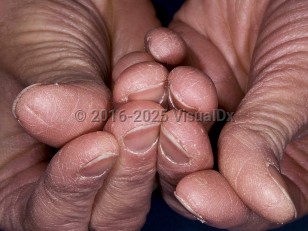Irritant contact dermatitis - External and Internal Eye
See also in: Overview,AnogenitalAlerts and Notices
Important News & Links
Synopsis

The hands are the most common location for irritant contact dermatitis, although any body surface may be involved. Eyelid areas are also easily affected due to the very thin skin of the region and the unwitting transmission of irritant substances by the hands. (See also Hand dermatitis.)
Patients with a history of atopic dermatitis are particularly predisposed. Environmental factors include repeated exposure to water or frequent hand washing, soaps and solvents, fiberglass, mild acids, and alkalis. Dry air can also predispose to irritant contact dermatitis. Exposures are frequently occupational. High-risk jobs include cleaning, health care, food preparation, and hairdressing. Irritant contact dermatitis can occur at any age. It is more common in women.
Codes
L24.9 – Irritant contact dermatitis, unspecified cause
SNOMEDCT:
110979008 – Primary irritant dermatitis
Look For
Subscription Required
Diagnostic Pearls
Subscription Required
Differential Diagnosis & Pitfalls

Subscription Required
Best Tests
Subscription Required
Management Pearls
Subscription Required
Therapy
Subscription Required
Drug Reaction Data
Subscription Required
References
Subscription Required
Last Updated:12/03/2017
 Patient Information for Irritant contact dermatitis - External and Internal Eye
Patient Information for Irritant contact dermatitis - External and Internal Eye- Improve treatment compliance
- Reduce after-hours questions
- Increase patient engagement and satisfaction
- Written in clear, easy-to-understand language. No confusing jargon.
- Available in English and Spanish
- Print out or email directly to your patient


